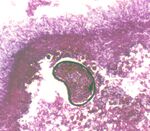Fungal Reproduction
Any fragment of hyphae can grow to form a new colony (if it is not too badly damaged). However, the main method of fungal reproduction is through spores which are produced in very large numbers. There are different types of spores: vegetative, asexual and sexual.
Vegetative spores can be divided into arthrospores and chlamydospores. Arthrospores are formed when septate hyphae disarticulate into separate cells. Arthrospores are usually formed by dermatophytes. Chlamydospoes are formed by segmentation of mycelium. They are thick walled, enlarged, resting spores which contain reserve food material and can remain viable after the rest of the mycelium has died. Budding from the ends or sides of the parent cell forms blastospores, for example, in Candidosis infections.
Asexual spores are either sporangiospores or conidiospores. Sporangiospores are formed when the cytoplasm cleaves within a sporangium (multinucleate segment of hyphae), producing either naked zoospores which have one or more flagella and are liberated through a hole in the sporangial wall or producing aplanospores. Aplanospores are non-motile and walled and are released when the sporangial wall breaks down. Conidiospores, such as Aspergillus can be formed directly from the mycelium, produced within a specialised fructification or can be formed externally by the abstriction of a conidiophore. Different types of conidia can be produced which differ in cell size and number and are called either microconidia (small and unicellular) or macroconidia (large and multicellular).
The sexual spores are divided into four categories depending upon the spores produced and their morphology. Zygomycetes are primitive fungi with a non-septate mycelium. The sexual spores are oospores or zygospores (the asexual spores are produced in a sporangium). Ascomycetes are higher fungi. They have a septate mycelium and the sexual spores are called ascospores (the asexual spores are conidia). Basidiomycetes are also higher fungi with a septate mycelium which has clamp connections. The sexual spores are basidiospores (the asexual spores are produced externally). Deuteromycetes are an artifical group of fungi which have an unknown sexual state.
Test yourself with the Fungi Flashcards
Reproduction of fungi
There are three types of reproduction of fungi as follows 1.vegetative 2.Asexual 3.Sexual The vegetative reproduction of fungi includin :- -fragmentation -budding -fission -sclerotia -rhiromorphs 2. Asexual reproduction of fungi including :- -zoospores -sporagiospores -chlamydospores -oidia -conidia 3.sexual reproduction of fungi including :- -planogametic copulation -gametangial contact -gametangial copulation -spermatiazation -somatogamy
